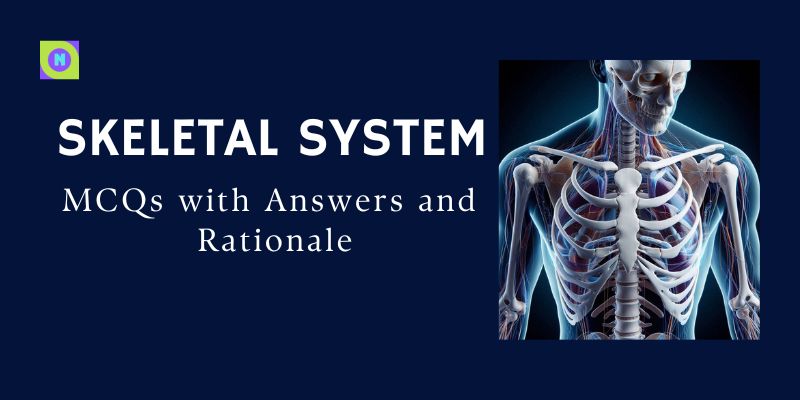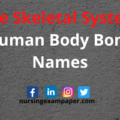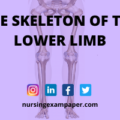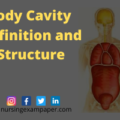The Skeletal System MCQs cover a broad range of topics related to the human skeletal structure, aimed at testing knowledge and understanding of its anatomy, functions, and disorders. These multiple-choice questions are designed to assess familiarity with bones, joints, and related terminology. They typically include inquiries about bone classification, such as long, short, flat, and irregular bones, and details about bone development, growth, and maintenance. Questions often delve into the functions of the skeletal system, which include providing structural support, protection of vital organs, storage of minerals like calcium and phosphorus, and serving as an attachment point for muscles to facilitate movement.
Additionally, MCQs might explore different types of joints—such as hinge, ball-and-socket, and pivot joints—and their respective functions in enabling various degrees and types of movement. Understanding these concepts is essential for healthcare professionals, anatomists, physical therapists, and anyone interested in human physiology and health sciences. The questions often include rationales to provide context and explanations, aiding in a deeper comprehension of skeletal system dynamics.
The Human Skeletal System MCQs Multiple Choice Questions
- Which of the following is not a function of the skeletal system?
A. Support
B. Movement
C. Digestion
D. Protection
Answer: C – The skeletal system supports the body, facilitates movement, and protects internal organs, but it is not directly involved in digestion.
- The skeletal system is composed of how many bones in the adult human body?
A. 206
B. 215
C. 220
D. 195
Answer: A – An adult human typically has 206 bones.
- Which type of bone tissue is responsible for the production of blood cells?
A. Compact bone
B. Spongy bone
C. Marrow
D. Cartilage
Answer: C – Marrow, found within bones, produces blood cells through a process called hematopoiesis.
- The longest bone in the human body is the:
A. Femur
B. Humerus
C. Tibia
D. Radius
Answer: A – The femur, or thigh bone, is the longest bone in the human body.
- Which bone is commonly referred to as the collarbone?
A. Scapula
B. Clavicle
C. Sternum
D. Humerus
Answer: B – The clavicle is commonly known as the collarbone. (The skeletal system Mcqs)
- The small bones in the fingers and toes are called:
A. Carpals
B. Metacarpals
C. Phalanges
D. Tarsals
Answer: C – Phalanges are the bones of the fingers and toes.
- The skull is made up of how many bones?
A. 22
B. 26
C. 28
D. 24
Answer: A – The human skull is composed of 22 bones.
- Which type of joint allows for the greatest range of motion?
A. Ball-and-socket
B. Hinge
C. Pivot
D. Gliding
Answer: A – Ball-and-socket joints, like the shoulder and hip joints, allow for a wide range of movement.
- Which bone is NOT part of the axial skeleton?
A. Rib
B. Femur
C. Vertebra
D. Sternum
Answer: B – The femur is part of the appendicular skeleton, not the axial skeleton.
- The process of bone formation is known as:
A. Ossification
B. Calcification
C. Cartilaginization
D. Mineralization
Answer: A – Ossification is the process by which bones are formed or created in the body.
- Which vitamin is essential for calcium absorption in bones?
A. Vitamin A
B. Vitamin C
C. Vitamin D
D. Vitamin K
Answer: C – Vitamin D is crucial for the absorption of calcium in the intestines, which is important for bone health. The skeletal system Mcqs
- The part of a long bone that is responsible for lengthwise growth during childhood is the:
A. Epiphysis
B. Diaphysis
C. Periosteum
D. Growth plate
Answer: D – The growth plate, or epiphyseal plate, is a cartilaginous area at the ends of long bones where growth occurs.
- Which joint is an example of a pivot joint?
A. Knee
B. Elbow
C. Neck
D. Hip
Answer: C – The neck (atlantoaxial joint) is an example of a pivot joint, allowing for rotation.
- Which bone forms the heel of the foot?
A. Talus
B. Calcaneus
C. Navicular
D. Cuboid
Answer: B – The calcaneus bone forms the heel of the foot.
- The periosteum serves what function in bones?
A. Blood cell production
B. Lubrication of joints
C. Bone growth
D. Protection and nourishment
Answer: D – The periosteum is a dense layer of vascular connective tissue that covers bones and provides protection and nourishment.
MCQs of The Skeletal System
- Which of the following bones is part of the pelvic girdle?
A. Scapula
B. Clavicle
C. Femur
D. Ilium
Answer: D – The ilium, ischium, and pubis together form the pelvic girdle.
- The process of removing old bone tissue and creating new bone tissue is called:
A. Ossification
B. Resorption
C. Mineralization
D. Calcification
Answer: B – Bone resorption is the process by which osteoclasts break down bone tissue.
- Which of the following bones is NOT part of the vertebral column?
A. Sacrum
B. Coccyx
C. Clavicle
D. Thoracic vertebra
Answer: C – The clavicle is not part of the vertebral column; it is a bone of the shoulder girdle. (The skeletal system Mcqs)
- The bone of the upper arm is called the:
A. Radius
B. Ulna
C. Humerus
D. Scapula
Answer: C – The humerus is the bone of the upper arm.
- Which of the following is NOT a type of bone tissue?
A. Compact bone
B. Spongy bone
C. Cartilage
D. Synovial bone
Answer: D – “Synovial bone” is not a recognized type of bone tissue.
- Which joint allows for movement in all three planes, including rotation?
A. Saddle joint
B. Condyloid joint
C. Hinge joint
D. Ball-and-socket joint
Answer: D – Ball-and-socket joints, like the shoulder and hip joints, allow movement in multiple planes, including rotation. The skeletal system Mcqs
- Which bone articulates with the scapula at the shoulder joint?
A. Clavicle
B. Humerus
C. Radius
D. Ulna
Answer: B – The humerus articulates with the scapula at the shoulder joint.
- The knee joint is an example of a:
A. Hinge joint
B. Ball-and-socket joint
C. Pivot joint
D. Gliding joint
Answer: A – The knee joint functions primarily as a hinge joint, allowing movement in one plane.
- Which of the following is NOT a function of cartilage in the skeletal system?
A. Providing cushioning between bones
B. Aiding in bone growth
C. Facilitating movement at joints
D. Producing blood cells
Answer: D – Cartilage does not produce blood cells; this function is performed by bone marrow.
- The bone of the lower leg on the medial side is called the:
A. Fibula
B. Tibia
C. Patella
D. Femur
Answer: B – The tibia is the larger bone of the lower leg on the medial side.
- Which of the following bones is NOT part of the cranium?
A. Parietal
B. Temporal
C. Maxilla
D. Occipital
Answer: C – The maxilla is a facial bone, not part of the cranium. (The skeletal system Mcqs)
- Which bone forms the forehead?
A. Frontal
B. Nasal
C. Zygomatic
D. Ethmoid
Answer: A – The frontal bone forms the forehead.
- The bones of the wrist are collectively known as:
A. Carpals
B. Metacarpals
C. Phalanges
D. Tarsals
Answer: A – The carpals are the bones of the wrist.
- The bones of the ankle are collectively known as:
A. Carpals
B. Metatarsals
C. Phalanges
D. Tarsals
Answer: D – The tarsals are the bones of the ankle.
- Which bone articulates with the humerus at the elbow joint?
A. Ulna
B. Radius
C. Scapula
D. Clavicle
Answer: A – The ulna articulates with the humerus at the elbow joint, along with the radius.
Solved Multiple Choice Questions on The Topic of Skeletal Tissues–
Skeletal system MCQS
- The lateral malleolus is a bony prominence found on which bone?
A. Tibia
B. Fibula
C. Calcaneus
D. Talus
Answer: B – The lateral malleolus is a bony prominence at the distal end of the fibula, forming part of the ankle joint.
- Which of the following is NOT a function of the skeletal system?
A. Regulation of body temperature
B. Storage of minerals
C. Protection of internal organs
D. Support and movement
Answer: A – Regulation of body temperature is not a function of the skeletal system.
- The process of bones becoming weaker due to loss of minerals is known as:
A. Osteomyelitis
B. Osteoporosis
C. Osteoarthritis
D. Osteogenesis
Answer: B – Osteoporosis is characterized by weakened bones due to loss of bone density and minerals.
- Which of the following bones is NOT part of the cranium?
A. Zygomatic
B. Parietal
C. Occipital
D. Sphenoid
Answer: A – The zygomatic bone is a facial bone, not part of the cranium. (The skeletal system Mcqs)
- Which structure connects muscles to bones?
A. Ligament
B. Tendon
C. Cartilage
D. Synovium
Answer: B – Tendons are fibrous connective tissues that attach muscles to bones.
- The process by which bones are fractured and then realigned in the correct position is called:
A. Reduction
B. Ossification
C. Articulation
D. Elevation
Answer: A – Reduction is the process of realigning fractured bones into their correct position.
- Which of the following bones is NOT part of the vertebral column?
A. Cervical
B. Sternum
C. Sacrum
D. Thoracic vertebra
Answer: B – The sternum is a bone of the thoracic cage, not part of the vertebral column.
- Which bone forms the posterior part of the hip bone?
A. Ilium
B. Ischium
C. Pubis
D. Acetabulum
Answer: B – The ischium forms the posterior part of the hip bone. (The skeletal system Mcqs)
- The bones of the fingers and toes are collectively known as:
A. Carpals
B. Metacarpals
C. Phalanges
D. Tarsals
Answer: C – The phalanges are the bones of the fingers and toes.
- The vertebrae are classified into how many regions?
A. 3
B. 4
C. 5
D. 6
Answer: A – The vertebrae are classified into cervical, thoracic, and lumbar regions.
- Which of the following bones is NOT part of the cranial vault?
A. Occipital
B. Sphenoid
C. Mandible
D. Parietal
Answer: C – The mandible (lower jaw bone) is not part of the cranial vault.
- The sacrum consists of how many fused vertebrae?
A. 2
B. 3
C. 4
D. 5
Answer: C – The fusion of five vertebrae forms the sacrum. (The skeletal system Mcqs)
- The atlas and axis are the first two vertebrae of which region?
A. Cervical
B. Thoracic
C. Lumbar
D. Sacral
Answer: A – The atlas (C1) and axis (C2) are the first two vertebrae of the cervical region.
- Which of the following bones is part of the appendicular skeleton?
A. Sternum
B. Rib
C. Scapula
D. Coccyx
Answer: C – The scapula (shoulder blade) is part of the appendicular skeleton.
- The primary ossification center in long bones is located in the:
A. Epiphysis
B. Diaphysis
C. Metaphysis
D. Periosteum
Answer: B – The primary ossification center is located in the diaphysis (shaft) of long bones.
The skeletal system mcqs with answers pdf
- Which of the following is a function of synovial fluid in joints?
A. Provides nutrients to bones
B. Lubricates joint surfaces
C. Forms new bone tissue
D. Produces blood cells
Answer: B – Synovial fluid lubricates joint surfaces, reducing friction during movement.
- Which type of joint allows for movement in only one plane (uni-axial)?
A. Ball-and-socket
B. Hinge
C. Saddle
D. Pivot
Answer: B – Hinge joints, like the elbow and knee joints, allow movement in one plane.
- Which bone articulates with the femur to form the knee joint?
A. Patella
B. Tibia
C. Fibula
D. Calcaneus
Answer: B – The tibia articulates with the femur to form the knee joint. (The skeletal system Mcqs)
- The coccyx is also known as the:
A. Tailbone
B. Breastbone
C. Collarbone
D. Hipbone
Answer: A – The coccyx is commonly referred to as the tailbone.
- Which bone forms the bridge of the nose?
A. Nasal
B. Maxilla
C. Mandible
D. Zygomatic
Answer: A – The nasal bone forms the bridge of the nose.
- Which of the following is NOT a function of the vertebral column?
A. Protection of spinal cord
B. Support of the body
C. Production of blood cells
D. Attachment point for muscles
Answer: C – The vertebral column supports the body, protects the spinal cord, and provides attachment points for muscles, but it does not produce blood cells. (The skeletal system Mcqs)
- Which bone is NOT part of the hand?
A. Radius
B. Ulna
C. Metacarpal
D. Phalanx
Answer: A – The radius is a bone of the forearm, not the hand.
- The process of bone remodeling is primarily controlled by:
A. Osteoblasts
B. Osteoclasts
C. Chondrocytes
D. Osteocytes
Answer: B – Osteoclasts are responsible for bone resorption and remodeling. (The skeletal system Mcqs)
- The bones of the shoulder girdle include:
A. Clavicle and scapula
B. Humerus and ulna
C. Radius and ulna
D. Femur and patella
Answer: A – The shoulder girdle consists of the clavicle and scapula.
- Which bone forms the base of the skull?
A. Temporal
B. Occipital
C. Frontal
D. Parietal
Answer: B – The occipital bone forms the base of the skull.
- Which of the following bones is NOT part of the axial skeleton?
A. Rib
B. Skull
C. Scapula
D. Sternum
Answer: C – The scapula is part of the appendicular skeleton. (The skeletal system Mcqs)
- The process by which cartilage is replaced by bone is called:
A. Ossification
B. Calcification
C. Mineralization
D. Resorption
Answer: A – Ossification is the process of cartilage being replaced by bone during development.
- Which of the following bones is NOT part of the lower limb?
A. Femur
B. Tibia
C. Ulna
D. Fibula
Answer: C – The ulna is a bone of the forearm, not the lower limb. (The skeletal system Mcqs)
- The anatomical term for a joint is:
A. Synapse
B. Ligament
C. Articulation
D. Tendon
Answer: C – An articulation refers to a joint where two bones meet.
- Which bone articulates with the acetabulum of the hip bone to form the hip joint?
A. Femur
B. Tibia
C. Fibula
D. Patella
Answer: A – The femur articulates with the acetabulum of the hip bone to form the hip joint.
MCQs on skeletal system with answers PDF Download
- Which of the following bones is NOT part of the axial skeleton?
A. Femur
B. Sternum
C. Hyoid
D. Sacrum
Answer: A – The Femur is part of the appendicular skeleton.
- The process of bone healing involves the formation of which type of tissue initially?
A. Cartilage
B. Bone
C. Fibrous tissue
D. Granulation tissue
Answer: D – Initially, bone healing involves the formation of granulation tissue at the fracture site.
- Which bone forms the anterior part of the pelvic girdle?
A. Ilium
B. Ischium
C. Pubis
D. Sacrum
Answer: C – The pubis forms the anterior part of the pelvic girdle. (The skeletal system MCQs)
- The anatomical term for the shoulder blade is the:
A. Clavicle
B. Scapula
C. Sternum
D. Humerus
Answer: B – The scapula is commonly known as the shoulder blade.
- Which type of joint allows for movement in multiple directions, including flexion, extension, abduction, adduction, and rotation?
A. Ball-and-socket
B. Hinge
C. Pivot
D. Gliding
Answer: A – Ball-and-socket joints, like the shoulder and hip joints, allow for a wide range of movement.
- The metatarsal bones are found in which part of the body?
A. Foot
B. Hand
C. Spine
D. Leg
Answer: A – The metatarsal bones are located in the foot, specifically between the ankle and the toes.
- The process of bone formation during fetal development is known as:
A. Ossification
B. Calcification
C. Mineralization
D. Chondrogenesis
Answer: A – Ossification is the process of bone formation, particularly during fetal development. (The skeletal system MCQs)
- Which of the following bones does NOT articulate with any other bone?
A. Hyoid
B. Mandible
C. Ulna
D. Clavicle
Answer: A – The hyoid bone is the only bone in the body that does not articulate with any other bone.
- Which bone forms the superior part of the nasal septum?
A. Nasal
B. Maxilla
C. Vomer
D. Zygomatic
Answer: C – The vomer bone forms the inferior and posterior part of the nasal septum.
- The olecranon process is a feature of which bone?
A. Humerus
B. Radius
C. Ulna
D. Scapula
Answer: C – The olecranon process is a prominent bony projection at the proximal end of the ulna, forming the elbow joint. The skeletal system MCQs
- Which of the following bones is NOT part of the ankle joint?
A. Tibia
B. Fibula
C. Calcaneus
D. Talus
Answer: A – The ankle joint is formed by the articulation of the tibia, fibula, and talus bones.
- The process of bone resorption is primarily carried out by:
A. Osteoblasts
B. Osteocytes
C. Osteoclasts
D. Chondrocytes
Answer: C – Osteoclasts are responsible for the process of bone resorption, breaking down bone tissue.
- Which of the following bones is part of the facial skeleton?
A. Parietal
B. Occipital
C. Maxilla
D. Sternum
Answer: C – The maxilla is a bone of the facial skeleton, forming the upper jaw. (The skeletal system MCQs)
- The process of bone growth in width, also known as appositional growth, occurs at the:
A. Epiphysis
B. Diaphysis
C. Metaphysis
D. Periosteum
Answer: D – Appositional growth occurs at the periosteum, where new bone tissue is added to the outer surface of existing bones.
- Which bone forms the prominent point of the elbow?
A. Humerus
B. Radius
C. Ulna
D. Scapula
Answer: C – The olecranon process of the ulna forms the prominent point of the elbow.
100 Questions about the skeletal system with answers
- The process by which bone tissue is replaced by fibrous tissue, resulting in bone formation, is known as:
A. Ossification
B. Osteoarthritis
C. Osteomalacia
D. Ossification center
Answer: A – Ossification is the process by which bone tissue is formed or replaced.
- Which bone is NOT part of the pectoral girdle?
A. Clavicle
B. Scapula
C. Humerus
D. Sternum
Answer: C – The pectoral girdle consists of the clavicle and scapula, which connect the upper limb to the axial skeleton. (The skeletal system MCQs)
- The process of bone remodeling is primarily regulated by which of the following cells?
A. Osteoblasts
B. Osteocytes
C. Osteoclasts
D. Chondrocytes
Answer: C – Osteoclasts are responsible for breaking down bone tissue during bone remodeling.
- Which bone forms the prominence of the cheek?
A. Zygomatic
B. Nasal
C. Frontal
D. Ethmoid
Answer: A – The zygomatic bone forms the prominence of the cheek.
- The process of bone formation where cartilage is gradually replaced by bone tissue is known as:
A. Calcification
B. Mineralization
C. Endochondral ossification
D. Intramembranous ossification
Answer: C – Endochondral ossification is the process where bone tissue gradually replaces cartilage during fetal development. (The skeletal system MCQs)
- Which bone articulates with the tibia and fibula to form the ankle joint?
A. Calcaneus
B. Talus
C. Navicular
D. Cuboid
Answer: B – The talus bone articulates with the tibia and fibula to form the ankle joint.
- The process of bone formation within a connective tissue membrane is known as:
A. Endochondral ossification
B. Intramembranous ossification
C. Osteogenesis
D. Mineralization
Answer: B – Intramembranous ossification is the process where bone forms directly within a connective tissue membrane. (The skeletal system MCQs)
- Which bone forms the posterior part of the hard palate and contributes to the nasal cavity?
A. Maxilla
B. Mandible
C. Palatine
D. Vomer
Answer: C – The palatine bone forms the posterior part of the hard palate and contributes to the nasal cavity.
- The collarbone is another name for which bone?
A. Clavicle
B. Scapula
C. Sternum
D. Humerus
Answer: A – The clavicle is commonly known as the collarbone.
- The carpal bones are found in which part of the body?
A. Foot
B. Hand
C. Spine
D. Leg
Answer: B – The carpal bones are located in the hand, specifically in the wrist area.
- The process of bone resorption involves the action of which type of bone cell?
A. Osteoblasts
B. Osteoclasts
C. Chondrocytes
D. Osteocytes
Answer: B – Osteoclasts are responsible for breaking down bone tissue during resorption.
- Which of the following bones forms the posterior part of the pelvis?
A. Ilium
B. Ischium
C. Pubis
D. Sacrum
Answer: B – The ischium forms the posterior part of the pelvis.
- The process of bone growth in length, occurring at the epiphyseal plate, is known as:
A. Ossification
B. Calcification
C. Endochondral ossification
D. Appositional growth
Answer: C – Endochondral ossification is the process where bone replaces cartilage at the epiphyseal plate during longitudinal growth. (The skeletal system Mcqs)
- The bones of the wrist are collectively known as the:
A. Carpals
B. Metacarpals
C. Phalanges
D. Tarsals
Answer: A – The carpals are the bones of the wrist.
- Which type of joint allows the greatest range of motion?
A. Hinge joint
B. Ball-and-socket joint
C. Pivot joint
D. Gliding joint
Answer: B. Ball-and-socket joint – Ball-and-socket joints, like the hip and shoulder joints, allow for the greatest range of motion due to their structure allowing movement in multiple directions.
The skeletal system mcqs pdf
- The tough, fibrous tissue that connects muscle to bone is called:
A. Tendon
B. Ligament
C. Cartilage
D. Fascia
Answer: A. Tendon – Tendons are strong cords of fibrous tissue that connect muscles to bones, enabling movement by transmitting the force generated by muscles to the bones they are attached.
- Which of the following bones is part of the axial skeleton?
A. Femur
B. Radius
C. Skull
D. Scapula
Answer: C. Skull – The axial skeleton includes the skull, vertebral column, and rib cage. It supports the central axis of the body.
- What type of joint is the elbow joint?
A. Hinge joint
B. Ball-and-socket joint
C. Pivot joint
D. Gliding joint
Answer: A. Hinge joint – The elbow joint is a hinge joint, allowing movement primarily in one plane (flexion and extension).
- The shaft of a long bone is called the:
A. Epiphysis
B. Diaphysis
C. Metaphysis
D. Periosteum
Answer: B. Diaphysis – The diaphysis is the long, tubular shaft of a long bone, composed of compact bone tissue.
- Which muscle type is striated and under voluntary control?
A. Smooth muscle
B. Cardiac muscle
C. Skeletal muscle
D. Involuntary muscle
Answer: C. Skeletal muscle – Skeletal muscles are striated (striped) and are under voluntary control, meaning their contraction is consciously controlled.
- Where would you find articular cartilage in the body?
A. Covering the ends of long bones
B. Between the vertebrae of the spine
C. In the trachea and bronchi
D. Surrounding the heart
Answer: A. Covering the ends of long bones – Articular cartilage covers the ends of bones at joints, providing a smooth, lubricated surface for movement.
- Which of these bones is not part of the human hand?
A. Scaphoid
B. Ulna
C. Capitate
D. Pisiform
Answer: B. Ulna – The ulna is one of the bones of the forearm, whereas the scaphoid, capitate, and pisiform are bones of the wrist and hand.
- Which condition is characterized by a progressive loss of bone density and strength?
A. Osteoarthritis
B. Osteoporosis
C. Rheumatoid arthritis
D. Gout
Answer: B. Osteoporosis – Osteoporosis is a disease where bone density decreases over time, making bones fragile and more susceptible to fractures.
- The region where two or more bones meet is called a:
A. Tendon
B. Ligament
C. Joint
D. Cartilage
Answer: C. Joint – A joint is the junction between two or more bones, facilitating movement and providing stability.
- Which of the following is a function of the synovial fluid found in joints?
A. Provides oxygen to joint tissues
B. Absorbs shock
C. Regulates blood pressure
D. Transports nutrients
Answer: B. Absorbs shock – Synovial fluid lubricates joints, reducing friction during movement, and also acts as a shock absorber.
If you can practice for online nursing and paramedical exams for job preparation. Click Here







